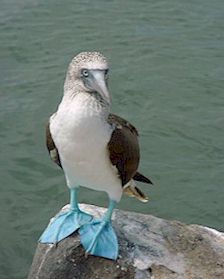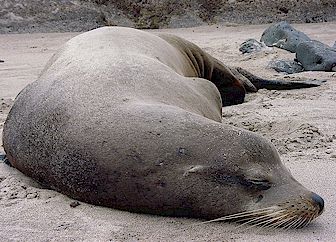Travel E-Logs #4 : San Cristobal
Dear Students:
Buenas
tardes desde Puerto Baquerizo Moreno en San Cristobal de las Islas Galapagos
del Ecuador.
(Good afternoon from Peurto Baquerizo Moreno on San Cristobal of the Galapagos
Islands of Ecuador.) In this report, we're going to focus on two things: español
y animales (Spanish and animals). Most people who live in the Galapagos
(and Ecuador and South America for that matter) speak Spanish; so, they don't
call pelicans 'pelicans,' they call them pelicanos; and they don't call
flamingos 'flamingos,' they call them flamencos. Likewise, they call
sharks tiburones, turtles tortugas
and finches pinzones.
You might notice that some Spanish words are spelled the same or almost the same as their English counterparts. That's because, even though Spanish and English have different linguistic parents, they grew up in the same neighborhood and therefore have lots of word forms in common. The word for 'animal' in Spanish, for example, is animal (only the pronunciation changes - though the plural is animales instead of 'animals.') The word for Spanish in Spanish, espanol, is not spelled exactly the same as in English, but it is easy to see that the root of the two words, span, is the same.
There are lots of these related words, or cognates, in Spanish and English. Here's a list of Spanish words for animals that live in Ecuador (some in the Amazon rain forest and some in or around the Galapagos Islands). Each word has an English cognate; so, see if you can figure out the English translations just by reading the Spanish words. (Click here to go to a Web page where you can hear the pronuciation of these words.)
Animal
Pelicano
Jaguar
Capibara
Delfin
Fragata
Armadillo
Anaconda
Boa
Insecto
Iguana
Pinguino
Tucan
Mosquito
Cucaracha
Raton
Caiman
Flamenco
Cormoran
Albatros
Raya
Tortuga Gigante
Tortuga
Marina
Pirana
==============================
Today, I woke up to an animal sound quiquiriqui (pr. key-key-ree-key). Well, that's the Spanish word for the sound anyway. Can you guess the animal? Here's a hint: The word is onomatopoeic, which means it sounds like what it represents. Just for fun, here's a list showing what quiquiriqui is in different languages:
Chinese
- wo-wo-wo
Danish
- kykliky
Finnish - kukkokeikuu
French - cocorico
German - kikeriki
Greek - kikiriki
Hebrew - coucouricou
Gaelic - cuc-a-dudal-du
Italian - chicchirichi
Japanese - kou-kou-kou-kou
Dutch - kukeluki
Norwegian - kukkeliky
Polish - kukuryky
Portuguese - cocorococo
Romanian - cucurigu
Russian - kou-ka-re-kou
Serbo-Croatian - kukuriky
Swedish - kuckeliku
And in English, in case you haven't figured it out yet, the mystery sound is, drum roll please: cock-a-doodle-doo! So, that makes the mystery animal, the rooster, or in Spanish, el gallo. That's right, chickens live in the Galapagos, though they are not endemic species. They were introduced on the islands by humans, as were goats, pigs, donkeys, horses and cows. Introduced animals are actually a major problem in the Galapagos. Can you guess why? I'll talk about it in an upcoming report.
Mystery Animal
Anyway, speaking of mystery animals, here's this report's guess-who math poem featuring a mystery Galapagos animal. Guess the animal and see if you can figure out what percentage of fish it catches on each attempt in the poem.
Of
the billions and billions of fish in the sea
A certain percentage are apportioned to me
I rise from the surface in a slow, heavy loop
Then crash with a splash, brandishing my scoop
When I bob back up, it's a pretty good bet
That I've got a bulge of wigglers, wiggling in my net
Taking
to the sky, I make my loop
Two hundred fish I spy, so I dive with a swoop
Plunging into the blue, I extend my scoop
A hundred twenty-two! Mmm-Mmm-Guuulp
Taking
to the sky, I make another loop
A hundred fish I spy, so I dive with a swoop
Plopping in the sea, I extend my scoop
This time twenty-three! Mmm-Mmm-Guuulp
Taking to sky, again I make a loop
Four lunkers I spy, so I dive with a swoop
Plunking near the shore, I extend my scoop
Yeah! I got all four! Mmm-Mmm-Guuulp
Taking to the sky, one more time I make my loop
A thousand fish I spy, so I dive with a swoop
I've never seen so many! I extend my scoop
Oh no, I didn't get any!
Oops.
Oh well, if at first I don't succeed I try and try again
The law of percentages says
Sooner or later I'll win
For of the billions and billions of fish in the sea
A certain percentage are apportioned to me
Guess who.
===============================
I'll
tell you the answers in the next report. By the way, as you probably guessed,
the mystery animal in the last report was the marine
iguana. The  body
parts represented in the poem were: the tail (1x1=1! , 'the rudder of my skiff'),
the feet (2x2=4), the toes/claws (5x4=20), the nostrils and the eyes (2x1x2=4),
the mouth (1x1=1), the spinal spikes (1x80=80) and the scales (60x260=15,600),
for a total of 15,710 body parts.
body
parts represented in the poem were: the tail (1x1=1! , 'the rudder of my skiff'),
the feet (2x2=4), the toes/claws (5x4=20), the nostrils and the eyes (2x1x2=4),
the mouth (1x1=1), the spinal spikes (1x80=80) and the scales (60x260=15,600),
for a total of 15,710 body parts.
Do you have a scientific mind? Do you wonder WHY a lot? You might be surprised to hear that, since coming to the Galapagos, Lilia and I have not seen a wide variety of animals, like we do when we visit schools in the Amazon rain forest. But, we have seen lots of the few animals the islands are famous for: in particular sea lions, pelicans, boobies, frigate birds, giant tortoises, marine iguanas and crabs. The incredible thing about the animals here, unlike in the rain forest, is you can get very, very close to most of them. For example, we've been swimming and lying on the beach with sea lions almost every day; students here tell us they have ridden on the backs of giant tortoises; today, a manta ray swam right underneath Lilia (that was a little too close!); and many of the birds will fly or land right near people, as if the people aren't even there! You can even get close enough to blue-footed boobies to take a close-up of their famous blue feet!
When
a scientist, like Charles Darwin, who visited the Amazon and the Galapagos,
observes such phenomena, the first question he or she asks is, 'Why?' Why are there relatively few animal species in the Galapagos while
there are so many in the Amazon? Why can you get so close to animals in the
Galapagos while in the Amazon usually you can't? Can you make a hypothesis or
two?
is, 'Why?' Why are there relatively few animal species in the Galapagos while
there are so many in the Amazon? Why can you get so close to animals in the
Galapagos while in the Amazon usually you can't? Can you make a hypothesis or
two?
You know that the Galapagos are volcanic islands and actually the tops of underwater mountains. They were formed by countless intermittent volcanic episodes that started millions of years ago and continue into our present era. When they first poked up out of the ocean, they were nothing but barren rock - solidified lava - not very hospitable hosts for life. But in time, some of the rock eroded into soil; and wind, waves and birds carried seeds, some of which can grew and survived in that soil, some of which adapted and developed characteristics that made them thrive in their new environment. Once plants colonized the land, plant-eating animals followed and a food chain was established. Again over many years, animals arrived by air, sea and floating vegetation, then evolved to maximize their potential for survival in the unique habitats of the islands. But, compared to the continents, the Galapagos are geological newborns. The evolutionary process started many millions of years earlier in the Amazon rain forest; so, an incredible number of different kinds of plants evolved there, each of which supported many different sets of animals. Eventually, the plant eaters adapted to fit predatory niches created by the abundance of species; and the preyed-upon developed a variety of techniques and characteristics that made them less likely to be eaten.
Large predators, however, never reached or never evolved on the Galapagos, so most of the animals never developed the instinct to flee from other animals - including people - which explains why Galapagos animals are so famously photogenic.
=========================
Q and A Exchange:
Here are some more answers to your questions, provided by fourth and seventh grade students from the Pedro Pablo Andrade School and Nueva Era Galapagos After School Program:
What
are the kids' favorite games and pastimes?
We like basketball, soccer, video games, Play Station,
chess, cards (including Burro Dudoso - Doubtful Donkey).
Why
are they called push-me, pull-me iguanas?
We don't call them that here, so we don't know about that.
[Note from Paul: We'll ask students on the other islands, too.]
What
language do most people speak?
Spanish, though most of us learn English in school. Some
people also speak Quichua. (Spanish is the official language.) 
What
time does it get dark?
The sun starts going down at 6:00 PM and it is completely
dark by 7:00.
What
kind of jobs do the people there have?
Our parents are fishermen, security guards, shopkeepers,
airport workers, engineers, sea or land taxi drivers, teachers, lawyers, politicians,
hotel owners and workers, police officers, post office workers, bank tellers
and restaurant owners.
What
kind of chores do you have?
We sometimes help to cook, wash dishes and clothes, make
our beds, take care of our brothers and sisters and feed the animals. Some of
us are scouts and we clean the beaches, paint murals and put up signs around
town.
What is the most popular kind of music?
We like reggae, ACDG, Ricky Martin, Valares, Papichulo,
Michael Jackson, salsa, cumbia and merengue.
What
is the average temperature in January?
18 to 25 degrees
centigrade.
What
entertainment systems do you have?
We have Play Station, Nintendo 64, Gameboy and others.
What
are your homes and schools like?
They are made of cement mixed with crushed lava and lava
stones with tin or tile roofs.
Do you have any volcanoes there and, if so, how do you protect yourself?
Volcanoes formed our island, but they are not active now
and we have never experienced a volcano in our lifetimes. We
are taught to go to a high place if a volcano erupts. [Note from Paul: We will
ask this question to students on other islands. San Cristobal is the oldest
island and therefore farthest east of the hotspot that formed the Galapagos.]
What
type of currency do you have and how does it compare to ours?
We use US dollars, same as you. (Our money used to be
called sucres but our country 'dollarized' a few years ago.)
What type of government system do you have?
We have a democratic system with a president, a congress
and deputies that represent different regions. We just had a presidential election
and Lucio Gutierrez won. He will soon be our new president.
========================================
That's all for this report. Next time, we'll hop back over to Santa Cruz. Till then, learn lots. Hasta pronto,
Paul Hurteau and Lilia Cai
=========================
Teachers: The 'cock-a-doodle-doo' information came from 'The Complete Chicken' by Pam Percy, Voyageur Press Inc.'
For links to Galapagos animal Web sites and photos, go here.
Index
Page
Meet the Adventure Team
E-Log #1:New York
E-Log#2: Quito, Ecuador
E-Log#3:
San Cristobal, Galapagos
E-Log #4: San Cristobal
E-Log#5: Santa Cruz
E-Log#6:
Santa Cruz
E-Log#7:
Santa Cruz
E-Log#8:
Isabela Island
E-Log#9:
Isabela
© 2007 OneWorld Classrooms. Text by Paul Hurteau. Photos by Dennis Pippen, Lilia Cai and Miguel Mosquero. All rights reserved.